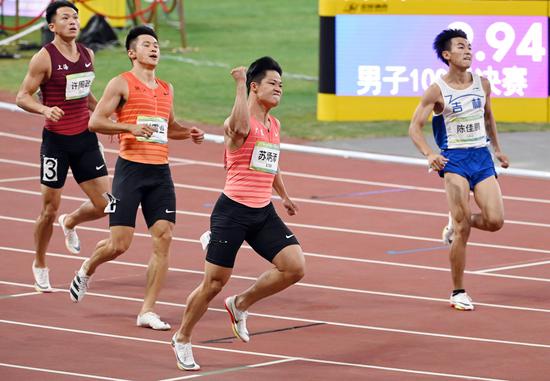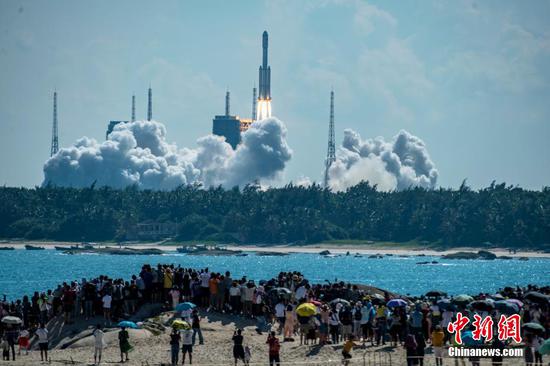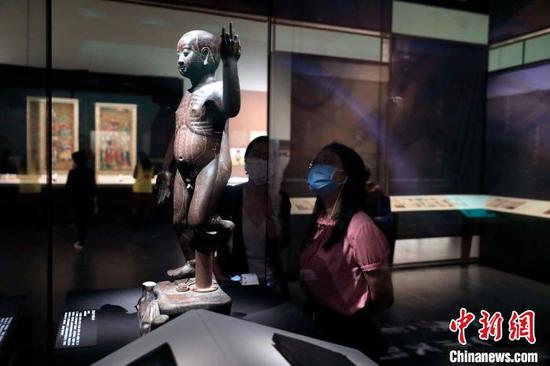
A visitor tries a VR spinning based on 5G technology at the digital achievements exhibition during the fourth Digital China Summit in Fuzhou, southeast China's Fujian Province, April 25, 2021. (Xinhua/Wei Peiquan)
A consistent innovation policy, increased spending on education and science and the ability to translate all these into sound results are behind China's current role as a global innovation leader, a senior official from the World Intellectual Property Organization (WIPO) told Xinhua on Thursday.
As per the WIPO's "Global Innovation Index (GII) 2021" released on Monday, China is still the only middle-income economy among the world's top 30 most innovative countries. It has established itself as a global innovation leader and is approaching the top 10.
According to the report, China has made continuous progress from ranking 14th last year to 12th this year and is now "knocking at the door of the GII top 10." This year, China also reached the top three in the Southeast Asia, East Asia and Oceania (SEAO) region for the first time.
According to Sacha Wunsch-Vincent, co-editor of the GII, China's success story can be explained by its consistent and persistent innovation policy planning and execution for more than three decades, as well as by the fact that it has impressively increased spending on education, science and technology.
But, more importantly, it is the country's ability to translate pro-innovation policy and innovation inputs into sound results, such as intellectual property, innovative products and high-tech exports.
"The speed with which China has built well-known high-tech firms, mostly in the information and communication technology (ICT) sector or the white goods sector, including large home appliances, etc., which are known around the world, has been impressive," Wunsch-Vincent said.
"The way these companies have consistently invented, filed for and used intellectual property, including trademarks, brands and design, is an important differentiating factor too."
He underlined that China has overtaken Japan, Germany and the United States in the number of international patent applications by origin, scaled by gross domestic product (GDP), and its lead is striking when considered in absolute terms. The same is true for the number of trademarks and industrial designs by origin as a percentage of GDP.
The latest GII results indicate that in terms of innovation clusters geographically, although the top 10 list remains the same as last year with only minor shifts, Shenzhen-Hong Kong-Guangzhou and Beijing now rank second and third, respectively, after the Tokyo-Yokohama cluster in Japan. Shanghai ranks eighth. Of the top 100 clusters, China has 19.
But what matters more than the numbers game is the constant pursuit of a "sound, organic innovation ecosystem in China, which is sufficiently connected to the innovation actors of other countries," Wunsch-Vincent said.
The GII, published annually, provides performance measures and ranks 132 economies on their innovation ecosystems. As in past years, Switzerland, Sweden, the United States and the United Kingdom continue to lead the innovation ranking.
Other countries in the GII top 10 include South Korea, the Netherlands, Finland, Singapore, Denmark and Germany.
Speaking of China's steady climb in the GII ranks since 2013, Wunsch-Vincent believes that it is not at all unnatural, as China's policy-makers have tried to consistently learn from and improve on their past innovation policies, while benchmarking current policies and performances against the past and against those of other countries.
"We can see an effort to improve further, be it in the field of reinforcing science-industry linkages, in further building Chinese innovation clusters, or in putting the huge stock of Chinese intellectual property filings to use via commercialization or cross-licensing," he said.
Despite the COVID-19 pandemic, the GII shows that global innovation has not slowed down, especially in areas where the aim is to overcome the pandemic. "Top countries and top firms have been relatively resilient, and they have spurred innovation throughout the crisis. Our data show that this is true for China," he added.
At the firms level, for example, the WIPO expert named companies such as Huawei, Alibaba, Tencent, Baidu and ZTE as ones that have performed strongly. So have other top research and development intensive companies in China, such as China Communications Construction, Power Construction Corporation of China and PetroChina.
Also, venture capital deals and deal values at the global level increased in 2020 and in the first quarter of 2021, largely due to a strong rebound in China.
"The full impact of the (COVID-19) crisis on innovation will be felt in the rankings over time only. Yet, the expectation is that Chinese firms will continue their innovation drive," he said.


















































 京公网安备 11010202009201号
京公网安备 11010202009201号